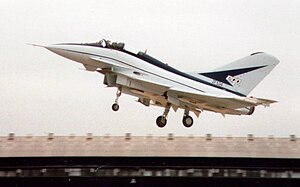
Back British Aerospace EAP German British Aerospace EAP Spanish British Aerospace EAP French BAe EAP Japanese British Aerospace EAP Malay British Aerospace EAP Slovenian British Aerospace EAP Swedish British Aerospace EAP Tajik
| EAP | |
|---|---|

| |
| EAP at the Farnborough Air Show, 1986 | |
| Role | Private venture demonstrator fighter |
| National origin | United Kingdom |
| Manufacturer | British Aerospace |
| First flight | 8 August 1986 |
| Retired | 1 May 1991 |
| Status | On display at RAF Cosford |
| Primary user | British Aerospace |
| Number built | 1 |
| Developed into | Eurofighter Typhoon |
The British Aerospace EAP (standing for Experimental Aircraft Programme) is a British technology demonstrator aircraft developed by aviation company British Aerospace (BAe) as a private venture. It was designed to research technologies to be used for a future European combat aircraft, and for the multinational Eurofighter Typhoon.
The EAP has its roots within the earlier Agile Combat Aircraft (ACA), a collaborative initiative studying advanced technologies to produce more capable fighter aircraft. Upon the announcement of the EAP during October 1983, it was intended to be a multinational European effort; however, neither West Germany nor Italy would ultimately contribute financially, thus the programme relied upon a combination of British public and British and European private funding instead. Having been manufactured in sections across multiple facilities, the sole EAP aircraft (serial ZF534) was rolled out during April 1986. Performing its maiden flight on 8 August 1986, the EAP would fly over 250 sorties prior to its grounding on 1 May 1991, by which point the aircraft had fulfilled its intended purpose as a development aid.
The British House of Commons Accounts Committee credited the EAP with reducing the development of the Eurofighter by a year for a saving of £850 million.[1]
During the second half of 1991, the Aeronautical and Automotive Engineering department of Loughborough University received the EAP aircraft, where it was used as a static instructional aid in the teaching of Aeronautical Engineering students for many years. In early 2012, in response to a request from the Royal Air Force (RAF), the EAP was transported to the Royal Air Force Museum Cosford; it has since been reassembled and put on public display in the museum's collection.